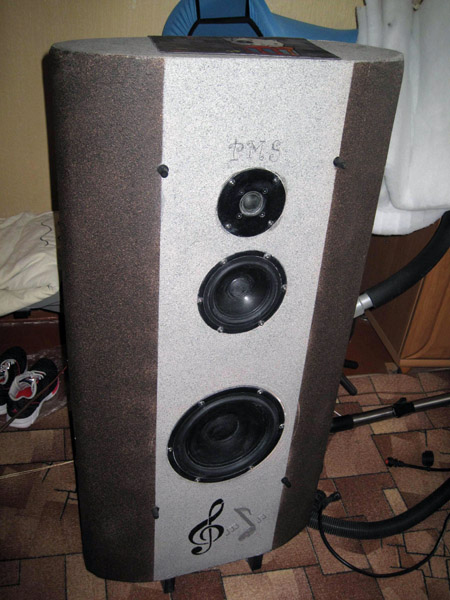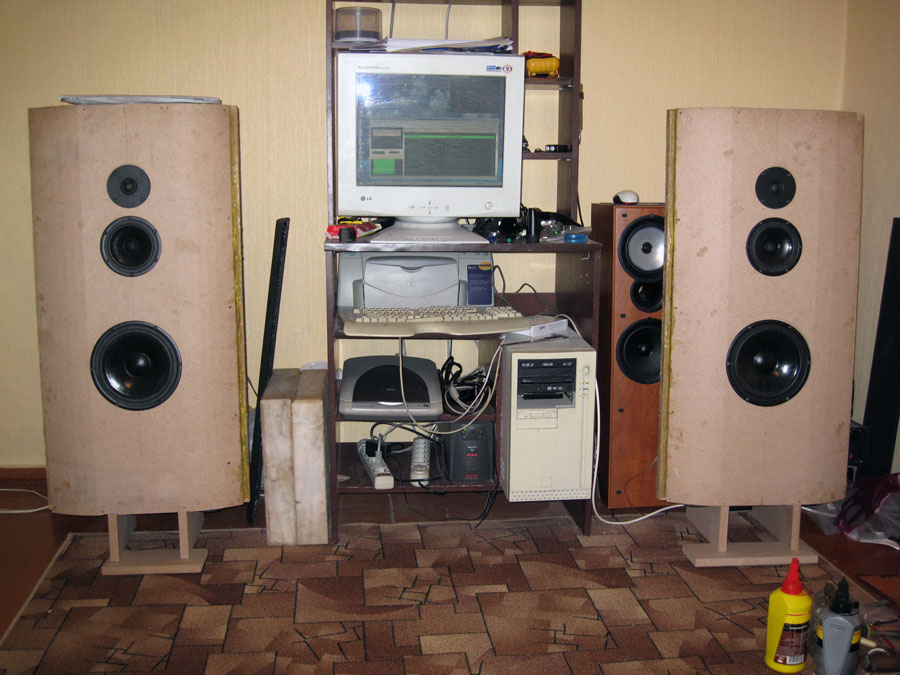Hi, Troels!
Today I have finished my PMS project!
The speakers haven't been finished yet. I have only constructed them so that they could play.
Please find attached a photo of my set up. I have a DIY DAC on PCM-63, DIY amplifier of a Russian constructor Zuyev, my old pair of speakers KEF Q55.2 and PMS which will replace my old KEF's.
Now I can see that a 3 way speaker is indeed much better sonically than 2.5 way.
The sound of PMS is awsome, very natural and non fatiguing.
The investment that I made is indeed worth it. Now I can see with my own eyes that DIY speaker can indeed be built for much less than any commercial speaker can be bought in any Hi Fi store. I guess I have saved at least US$2,000 by bying the kit from Jantzen Audio.
I have paid about Euro 630 for the kit from Jantzen Audio including the drivers, shipment and everything else that I would need for a pair of speakers. Then I bought locally 22mm MDF sheet for about Euro 50 and asked my friend working as a carpenter to cut MDF according to the specifications that I took from your website. Luckily my carpenter friend did not charge me for this work. As soon as all the parts have been cut I started to glue them together. I want to stress that I have had no prior experience in woodworking. In spite of that I decided to take a chance doing it myself.
It took me about a month to complete the project. In some difficult cases I asked questions some more experienced speaker builders on internet forum in Russia www.vegalab.ru who explained to me all the details that I had to be aware of. Also I sent you one or two emails with my questions. So here I am listening to a pair of PMS that I have constructed with my bare hands with absolutely no prior woodworking experience!
All the cabinet sizes and crossover schematics were closely adhered to according to your website.
The most obvious thing that I can hear from day #1 is very smooth and non fatiguing sound, In contrast on many albums my KEF's sound harsh.
I will try to compose a more detailed report on how I constructed my pair of PMS.
Please feel free to use anything that I sent you for any purpose.
Thanks for your support and your assurances half a year ago that DIY speaker can sound just like a commercial speaker which is two or three times more expensive. It's great to be a DIY speaker builder without any previous woodworking skills.
Many happy returns from Siberia (Siberian town of Kemerovo in Russia)!
Regards, Vladimir
Hi, Troels.
I would like to tell you about my ordeals in fine tuning the
vent on PMS. During the first month of listening to PMS I liked
the maximum length of the vent supplied by Jantzen which is
about 12 cm. But as soon as I cut it to 8 cm as had been
suggested by you I felt that the bass was not hard enough and by
increasing the length of the vent to 12 cm the resonance
frequency became lower and this was pleasant to my ears as I
mistakenly thought that thus I I got more bass and better bass
as it seemed to me harder. However when the vent length
increased to 12 cm (about 34 Hz) the level of bass decreased and
(as you might recall) I started tinkering with the crossover
trying to increase the bass. Having listened to the modified
version of the crossover (one additional 1 Ohm resistor in the
treble and mid cicuit) first I was happy by increased level of
bass but then I found that this modification deteriorated the
quality of mid on high quality recordings not to mention the
fact that this modification increased output of the woofer in
all the band up to 340 Hz whereas what I wanted was only
elevation in the 30-50 Hz area. So I quit this modification and
came back to the original scheme of the crossover. A few days
ago at long last it ocurred to me that many recordings (for
instance, albums by Electric Light Orchestra) simply do not
contain 30-40 Hz hard bass that I was looking for and by
lowering the resonance frequency by increasing the vent length
I, sort of, lost the middle bass in chasing the hard bass which
simply does not exist in many albums. So, finally I came back to
8 cm length of the vent and now although the resonance frequency
has been somewhat increased (which I can hear very well) and
hard bass, sort of, disappeared if you understand what I mean by
this, I can now hear, enjoy and appreciate the increased level
of detail in mid bass (around 100 Hz and higher) which is good.
So during this half a year of listening and fine tuning my PMS I
sort of evolved into a more experienced listener so to say.
Regards Vladimir
Hi, Troels,
I have been tinkering some more with PMS and came to conclusion
that it can produce very good bass if it is placed in the right
position in the room and the length of the vent should be 12 cm
(not 10cm as I thought before). With 10cm length of the vent the
bass is too booming and with 12 cm it has just the right tone.
Firstly I placed the speakers 90 cm from the rear wall because I
have furniture near the wall and if the speakers are placed too
close to the wall the sound reflections from the furniture spoil
the image. Therefore I had to place the speakers 90 cm from the
wall. In this position there is certain lack of bass at 12 cm
vent. So I listened to music with 10 cm vent since this length
gives more bass. And so I have been using PMS in this position
for half a year may be and got used to a thought that may be PMS
can not produce really low and strong bass but fortunately on the
1st of March 2012 I tried to change the vent length back to 12 cm
and covered my furniture with a bed sheet which does not allow
reflection of the sound off the furniture. Then I put my speakers
80 cm from the wall and finally I got a very deep bass without
any boominess. So now I must say that all this talking by other
builders about PMS not having strong and deep enough bass is not
correct. PMS can produce very good bass on properly recorded
material with 12 cm vent length and proper room positioning. Just
use room gain and treat the room with some sound absorbing
material and this will be worth it. The only problem or
inconvenience that I came across is what is the best way to
adjust the vent length. I make it by gluing several pieces of a
previously cut vent by a piece of sticky tape. May be I should
order 4 more 12cm pieces of vent from Jantzen Audio? The size of
my listening room is 3 by 6 meters (18 sq. m) and the speakers
are placed near the long wall.
Regards Vladimir
29-10-2012
After tinkering with my PMS for almost
one and a half years I have finally come to conclusion
that the best sounding length of the port is 8 cm.
Although at this length it is not easy to obtain
correct and linear reproduction of bass (whereas
at 12 cm length it is pretty easy to get rid of
boomines but 12cm does not provide enough bass) at 8
cm PMS is more susceptible to boomy sound if placed
incorrectly in the room.
For instance when I placed PMS across the rectangular
room (6x3 meters) I coud not get rid of boomy sound at
8cm, but when I placed them along my room at golden
ratio formula I got the maximum amount of bass at 8cm.
So from now on I am sticking with 8cm length of
the port.
I want to tell you as well that when I played sound
from signal generator on my PC I discovered that at
12cm the lowest reproduced frequency was 35Hz but at 8
cm the lowest frequency that I heard was 25Hz! At
28-29 Hz my windows start shattering. How can that be
that the low bass is better reproduced at higher
tuning frequency of the port?
I believe that the final result of my findings should
be published on your website to assist other DIYers
with their PMS constructions.
It is so much easier when you don't have to experiment
with port tuning by having someone else doing it and
telling you what to do.
21-04-2013
Hi, Troels, Today I have
finally solved the bass problem with my PMS. I remember reading
your comments wherein you advised against putting too much damping
material in the cabinets. Generally I kept to your advice when I
assembled my pair of PMS but unfortunately I have been having some
discontent with the quantity of bass in my speakers. Today I
opened them and looked closely at the bass section and what did I
see? The egg crate foam behind the woofer was attached not only
directy behind it but also in the left and right wings of the
cabinet which are located quite far from the area directly behind
the woofer. I thought to myself that may be the egg crate foam in
the wings was not good for bass. So I took it off. After
assembling the cabinet and putting on some music my jaw dropped in
amazement. This is the bass that I was dreaming of! Now my
speakers sound amazing.
A few days ago I visited a friend with
B&W 804s (Nautilus). They produced punchy bass that PMS could
never compete with, but because of this subwoofer type of bass I
did not hear any upper midbass. The mids in PMS are significantly
better than in B&W. As regards the highs the quality of treble in
PMS was not in any way inferior to B&W.
So, the past few days I
was under the impression of hearing that punchy bass (by two 6.5
inches woofers) and the only thought that was chasing my mind was
why an 8 inch woofer in my PMS did not produce the bass that I
wanted to hear and I was considering assembling a subwoofer to
hear the bass that I craved for. Now I know why and I no longer
want a subwoofer. Hope that this info will assist other DIY'ers.
Regards Vladimir |

